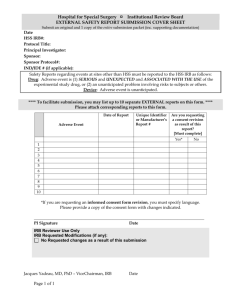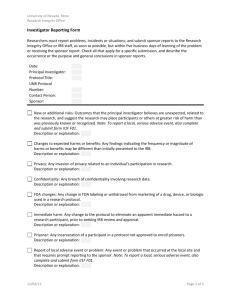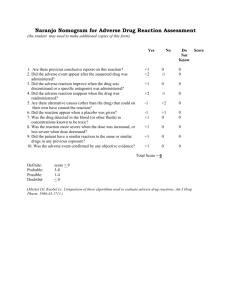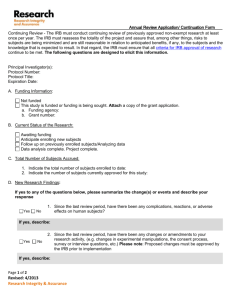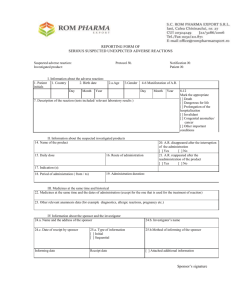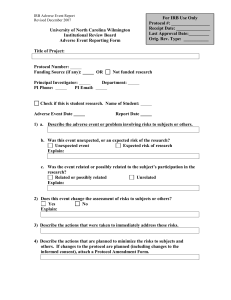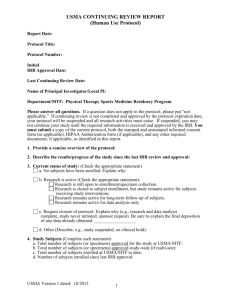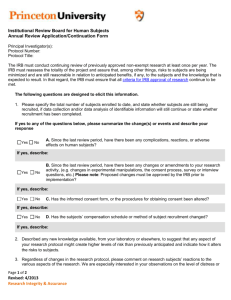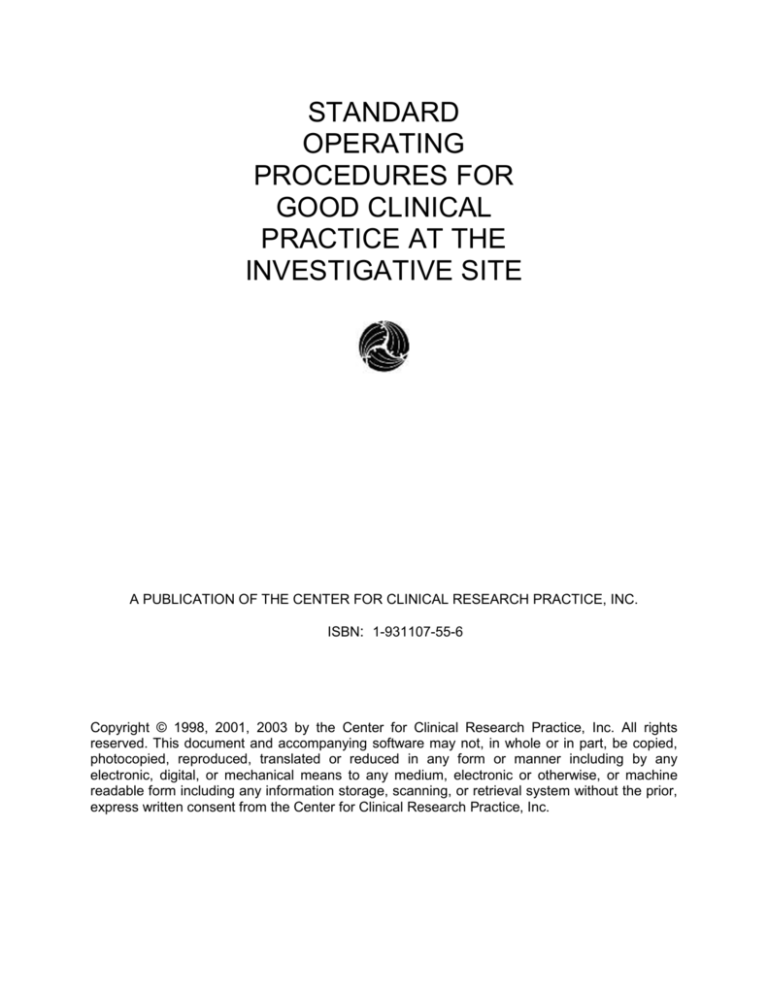
STANDARD
OPERATING
PROCEDURES FOR
GOOD CLINICAL
PRACTICE AT THE
INVESTIGATIVE SITE
A PUBLICATION OF THE CENTER FOR CLINICAL RESEARCH PRACTICE, INC.
ISBN: 1-931107-55-6
Copyright © 1998, 2001, 2003 by the Center for Clinical Research Practice, Inc. All rights
reserved. This document and accompanying software may not, in whole or in part, be copied,
photocopied, reproduced, translated or reduced in any form or manner including by any
electronic, digital, or mechanical means to any medium, electronic or otherwise, or machine
readable form including any information storage, scanning, or retrieval system without the prior,
express written consent from the Center for Clinical Research Practice, Inc.
Date of version: 12/30/2010
Replaces previous version: 07/01/2009
Approved by: _____________________________
SM - 404
STANDARD OPERATING PROCEDURE
FOR ADVERSE EVENT REPORTING
1. INTRODUCTION
Subject safety is of the greatest importance for both the individual subject and
the goals of the clinical study. Investigators are required to report to the sponsor
all adverse events occurring during a study. If the event is serious and
unexpected, prompt reporting to the sponsor and to the IRB is mandatory. This
standard operating procedure (SOP) describes the steps this clinical research
team follows to fulfill the regulatory and clinical requirements for adverse event
reporting.
2. SCOPE
This standard operating procedure (SOP) describes the responsibilities of the
research team for managing, reporting and documenting adverse events from the
time an adverse event is identified until all follow-up activities associated with its
resolution have been completed. This SOP also describes the mechanisms used
to provide the information necessary for sponsors to prepare Investigational New
Drug (IND) safety reports. Finally, the procedures for processing and transmitting
IND safety reports received from the sponsor to the IRB are defined.
3. APPLICABLE REGULATIONS AND GUIDELINES
21 CFR 312.32
21 CFR 312.33
21 CFR 312.44
21 CFR 50.25
21 CFR 56.108
21 CFR 56.109
21 CFR 56.115
45 CFR 46.103
45 CFR 46.109
45 CFR 46.115
45 CFR 46.116
IND safety reports
Annual reports
Termination
Elements of informed consent
IRB functions and operations
IRB review of research
IRB records
Assuring compliance with this policy-research
conducted or supported by any Federal Department
or Agency
IRB review of research
IRB records
General requirements for informed consent
1
SM-404, Adverse Event Reporting
Date of version: 12/30/2010
Replaces previous version: 07/01/2009
FDA Information
Sheets, October
1998
May 1997
Continuing Review After Study Approval
International Conference on Harmonisation; Good
Clinical Practice: Consolidated Guideline
4. REFERENCES TO OTHER APPLICABLE SOPS
GA-102
PM-301
PM-302
SM-403
DM-501
RR-403
Responsibilities of the Research Team
Site-Sponsor/CRO Communications
Interactions with the Institutional Review Board
Subject Management While on Study
Data Management
IRB SOP – Serious and Unexpected Adverse
Events
5. ATTACHMENTS
A. MedWatch Form – FDA 3500
B. MedWatch Form – FDA 3500A
C. Procedures for Managing Adverse Events
6. RESPONSIBILITY
This SOP applies to those members of the clinical research team involved in
ensuring the appropriate management of adverse events. This includes the
following:
Principal investigator
Sub-investigator
Director, Research & Innovation
Clinical Research Coordinator
Data / Finance Analyst
7. DEFINITIONS AND GLOSSARY
The following definitions from the Code of Federal Regulations and the
International Conference on Harmonisation, Good Clinical Practice:
Consolidated Guideline apply to this SOP.
Adverse event: An adverse event (AE) is any untoward medical occurrence in a
patient or clinical investigation subject administered a pharmaceutical product
and that does not necessarily have a causal relationship with this treatment. An
AE can therefore be any unfavorable and unintended sign (including an abnormal
laboratory finding), symptom, or disease temporally associated with the use of a
2
SM-404, Adverse Event Reporting
Date of version: 12/30/2010
Replaces previous version: 07/01/2009
medicinal (investigational) product, whether or not related to the medicinal
(investigational) product.
Associated with the use of the drug: There is a reasonable possibility that the
experience may have been caused by the drug.
Disability: A substantial disruption of a person’s ability to conduct normal life
functions.
Life-threatening adverse drug experience: Any adverse drug experience that
places the patient, in the view of the investigator, at immediate risk of death from
the reaction as it occurred, i.e., it does not include a reaction that, had it occurred
in a more severe form, might have caused death.
Serious adverse drug experience (ADE): Any experience that results in death,
in a life-threatening ADE, inpatient hospitalization or prolongation of
hospitalization, a persistent or significant disability or incapacity, or congenital
anomaly.
Unexpected adverse drug experience: Any adverse experience the specificity
or severity of which is not consistent with the current Investigator Brochure, or if
an Investigator Brochure is not required, that is not consistent with the specificity
or severity in the risk information described in the general investigational plan or
elsewhere in the current application, as amended.
8. PROCESS OVERVIEW
A. Managing adverse events
B. Handling IND safety reports from sponsors
C. Reporting to the IRB
9. PROCEDURES
A. Managing adverse events per protocol and federal regulations
PI
Sub-investigator
Clinical Research
Coordinator
Follow up appropriately when a research subject
experiences any adverse change from baseline or
pretreatment condition, ensuring that all appropriate
resources are directed toward subject safety and
well-being. Follow the subject until the event is
resolved.
If necessary for the immediate medical care of the
subject only, break the drug blind after consultation
(if possible) with the sponsor.
3
SM-404, Adverse Event Reporting
Date of version: 12/30/2010
Replaces previous version: 07/01/2009
PI
Clinical Research
Coordinator
If the adverse event is serious and/or unexpected,
inform the sponsor as soon as possible after the
subject is stabilized. Provide as much information as
is available.
Record the details of the adverse event in the
source documentation and complete the appropriate
CRFs.
Clinical Research
Coordinator
Keep originals or photocopies of all relevant
documentation, including facsimile confirmations,
and file in the study binder with appropriate
documents.
B. Handling IND safety reports from sponsors
PI
Sub-investigator
Clinical Research
Coordinator
All research staff
involved in subject
assessment and care
Clinical Research
Coordinator
Promptly review IND safety reports received from
sponsors.
File IND safety reports in the study regulatory file.
Refer to IRB SOP #RR-403
C. Reporting to the IRB
PI
Clinical Research
Coordinator
Sub-investigator
Ensure that the IRB is notified of all serious or
alarming events occurring at this site during the
approval period for the ongoing study. This should
be done within 24 hours of the site becoming aware
of the event.
Ensure that all IND safety reports received from
sponsors are promptly submitted to the IRB. This
should be done within 10 days of receipt of the
safety reports.
Ensure that the clinical site reports to the IRB all
unreported serious adverse events as part of the
periodic or annual reporting requirements.
4
Attachment A
FORM FDA 3500
To retrieve (PDF) format of the above forms go to web site:
http://www.fda.gov/AboutFDA/ReportsManualsForms/Forms/default.htm
This form may be completed electronically.
Attachment B
FORM FDA 3500A
To retrieve (PDF) format of the above forms go to web site:
http://www.fda.gov/AboutFDA/ReportsManualsForms/Forms/default.htm
This form may be completed electronically.
Attachment C
PROCEDURES for MANAGING ADVERSE EVENTS
1. Identification, assessment and management of an adverse event
REGULATIONS
PROCEDURES
Definition of an adverse event (AE):
Any adverse change from baseline
(pretreatment) intercurrent illness
which occurs during the course of a
clinical study after treatment has
started, whether considered related to
treatment or not
Any effect that is unintended and
unfavorable, such as a sign, a
symptom, a laboratory abnormality or a
disease or condition
Ensure that the following are appropriately
investigated:
Spontaneous reports by subjects
Observations by clinical research staff
Reports to research staff by family or
medical care providers
Possible AEs documented in medical
records, progress notes, etc.
Reports of a subject death within four
weeks after stopping treatment or
during the protocol-defined follow-up
period, whichever is longer, whether
considered treatment-related or not
Serious adverse events (SAEs) include:
Death
Life-threatening experience
Inpatient hospitalization or prolongation
Persistent or significant
disability/incapacity
Congenital anomaly/birth defect
Events that would require medical or
surgical intervention to prevent any of
the above
Manage the adverse event to ensure that
all appropriate resources are directed
toward subject safety and well-being.
Institute therapeutic intervention/support
measures. If applicable:
Discontinue the investigational product,
comparator, or placebo
Reduce dosage (as per protocol)
Interrupt drug (as per protocol)
Challenge (as per protocol)
Follow the subject and assess the adverse
event until stabilized/resolved.
2. Reporting SAEs to the sponsor
Report serious and unexpected adverse experiences, whether considered drug-related
or not, to the sponsor as soon as possible.
Provide details to the sponsor as they become available. If additional information cannot
be obtained for whatever reason, document this.
Inform the sponsor when no other information is expected.
SPONSOR RESPONSIBILITIES
SITE RESPONSIBILITIES
Sponsors are required to notify the FDA by
IND safety reports of any serious adverse
experience associated with use of the
drug in the clinical studies conducted
under an IND as soon as possible but no
later than 15 calendar days after initial
receipt of the information.
To meet expedited reporting requirements,
inform the sponsor as soon as possible
after the subject is stabilized.
If the event is fatal or life-threatening and
associated with use of the drug,
sponsors are required to notify the FDA by
telephone or fax within 7 calendar days of
initial receipt of the information.
Provide as much of the following
information as is available:
Protocol name and number
The possible test articles:
investigational product, comparator, or
placebo
Lot number and expiration date
Subject identifiers
Demographic data
The nature of the event
The severity of the event
The probable relationship of the AE to
the investigational product
The date (and time) of AE onset
The date (and time) of AE resolution, if
available
The dose, frequency, and route of
administration
The start and stop dates of test article
administration
Concomitant medications and
therapies
Clinical assessment of the subject at
this time
The results of any laboratory and/or
diagnostic procedures, treatment,
autopsy findings
The follow-up plan
The outcome
3. Research documentation
SOURCE DOCUMENTATION
CASE REPORT FORM COMPLETION
Record in the source documentation,
noting
The nature of the event
The severity of the event
The probable relationship of the AE to
the investigational product
The date (and time) of AE onset
The date (and time) of AE resolution, if
available
The possible test articles:
investigational product, comparator, or
placebo, the dose, frequency, and
route of administration
The start and stop dates of test article
administration
Concomitant medications and
therapies
Clinical assessment of the subject at
this time
The results of any laboratory tests
and/or diagnostic procedures
The follow-up plan
The outcome
Complete the appropriate case report
form(s)
The site-prepared data collection form
for SAEs or
The sponsor-generated CRF for routine
AEs
4. Sponsor-generated IND safety reports
RESPONSIBILITIES TO IRB
Submit all IND safety reports to the
IRB and retain a copy of the transmittal
memo in the study regulatory binder.
RESPONSIBILITIES TO SPONSOR
Acknowledge receipt of expedited
safety report to sponsor with
letter/facsimile.
Copy sponsor on the transmittal memo
to the IRB, if required.
Inform sponsor of action required by
the IRB, such as revisions to the
informed consent form.
Follow up with the sponsor as required.

